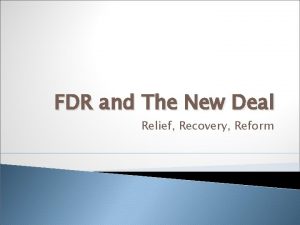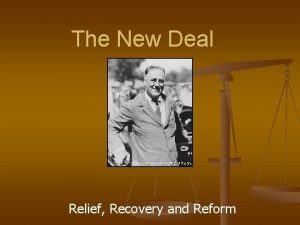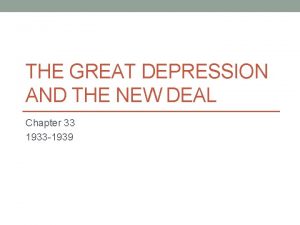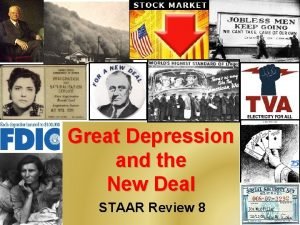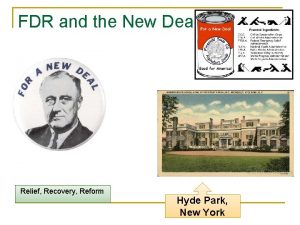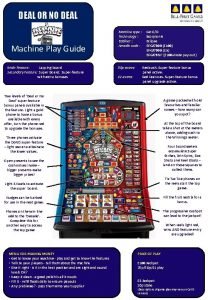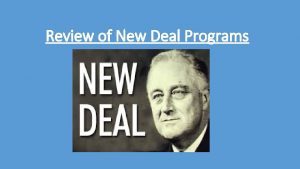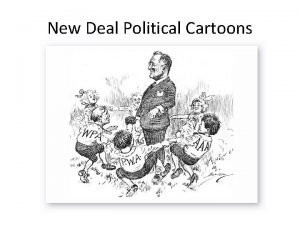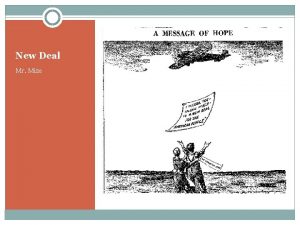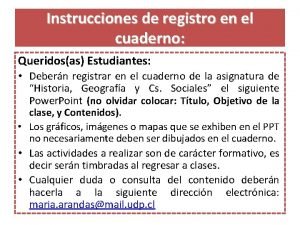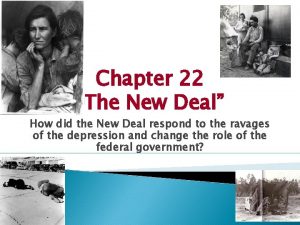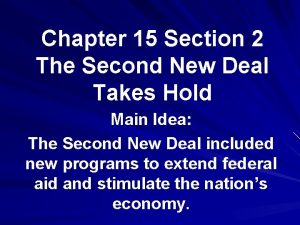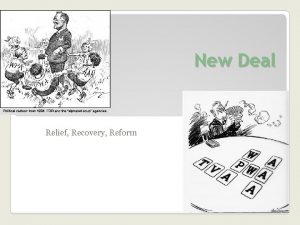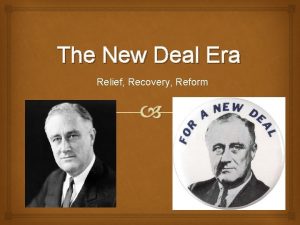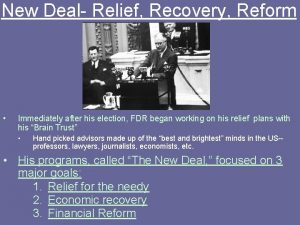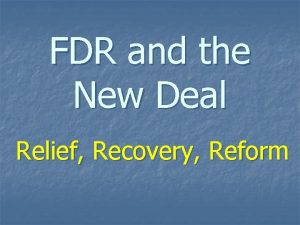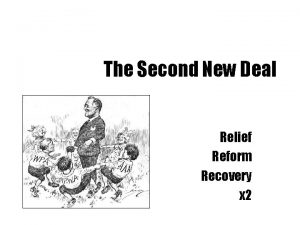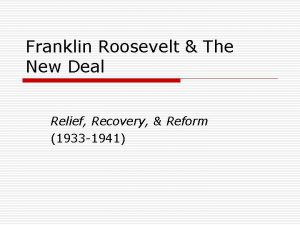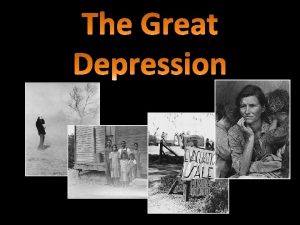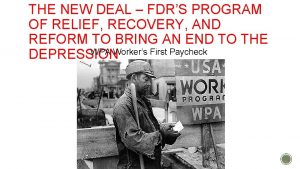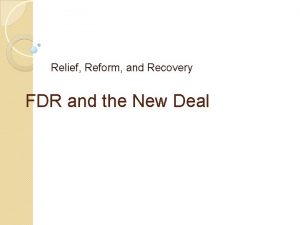Relief Reform Recovery The New Deal from March





















- Slides: 21

“Relief, Reform, Recovery”: The New Deal *from March 4, 1933 to Congress’ June adjournment: 100 days *”The Hundred Days” featured 15 proposed bill packages--A heavily Democratic Congress passed them all *Despite his early campaign rhetoric, FDR’s domestic programs would represent a complete rejection of laissezfaire tradition

The Early New Deal (1933 -’ 34) • Direct relief: The Federal Emergency Relief Administration (FERA) provided national government money for aid to citizens--$500 million • State and local governments would distribute the money • Harry Hopkins administered the agency; he was a New York social work reformer who would also be committed to ending racial discrimination with regard to relief

The government as employer • The Civilian Conservation Corps put unemployed 18 -25 year old men to work planting trees, building roads, controlling floods, and improving national parks • They earned $30/month, sending $25 home to families • 2. 5 million boys worked in 1, 500 CCC camps by 1942

Hands-on regulation • The Agricultural Adjustment Act led to the AAA(dministration); it set prices for farm commodities and began the practice of subsidies, payments to farmers who would reduce their production • The National Industrial Recovery Act yielded the NRA, which tried to set industrial codes that regulated price and production … large companies tended to write the codes for their industries

The President’s Critics Force Him to Get More Radical: *Success of far-left candidates like Upton Sinclair in CA (gov’t-run production, monthly pensions); Francis Townsend’s “Golden Age Clubs”; Huey Long’s “Share our Wealth” programs *aggressive and possibly militant unions (responding to section 7 a of the NIRA)

Rooseveltian critics: Francis Townsend • A retired physician from California, he built an interest group that called for an “Old Age Revolving Pension Plan” that would offer $200/month to all people over 60— who would then have to spend it in 30 days • He gained 3 million followers and criticized Roosevelt’s inactivity

Rooseveltian critics: Huey Long • • Maybe the most radical politician in American history, the Louisiana Governor (and eventually Senator) created the “Share Our Wealth” society, designed to “break up the swollen fortunes of America and to spread the wealth among all our people. ” All Americans could have a homestead worth $5000, he suggested, and guaranteed income of $2500 “Every Man a King” • He was murdered in 1935 •

Rooseveltian critics: militant unions • The NIRA suggested that workers should be allowed to bargain collectively with their employers, raising union hopes: • 1. 5 million workers organized 1, 800 strikes in 1934 • Violence by and against striking workers spread; 100, 000 people mobilized in Minneapolis, thousands in San Francisco

FDR and the Brains Trust responded with the “Second New Deal” • The WPA, Resettlement Administration, and NHA enhanced redistribution and hands-on government (and required higher “soak the rich” taxes) • The Social Security Act defused Townsend and others—and established the most wide-ranging legislation in American history • The NLRA and Fair Labor Standards Act guaranteed collective bargaining and a minimum wage

The Social Security Act • Passed in 1935, it created old-age pensions and established unemployment insurance • A payroll tax on workers and employers created a fund; from that monthly pensions were paid to retirees after the age of 65 • It has been amended and altered many times, but the program and principle remain …

Social Security today: • Of the estimated $4 trillion budget for next year, more than $2. 2 trillion is “non-discretionary”—it must, by law, be paid • Social Security, funded by the FICA line on your paycheck will account for $850 billion of that— the largest single chunk • It will run a surplus until 2017 (if no adjustments are made …) • Almost 80% of Americans think it has been a positive program … 454 million numbers have been issued

The NLRA and FLSA: • The National Labor Relations Act (1935) gave a clearer guarantee of the right for workers to organize trade unions and bargain collectively, a real win for labor: oft-referred to as the Wagner Act, for its sponsor, or the “Magna Carta for Labor” • The Fair Labor Standards Act set the first national minimum wage (25 cents/hour) and set a maximum work week of 44 hours for workers contributing to interstate commerce

Complications. . . • The Supreme Court declared the NRA and AAA to be unconstitutional, leading to FDR’s ill-fated “court-packing” scheme

The Roosevelt Recession • In 1937 the Administration, noting unemployment levels that had fallen to 14%, ag prices back to 1930 rates, and GDP back up to 1929 levels, backed off of the New Deal … FDR tried to propose debt-reducing initiatives … and a nasty recession came back • (see table)

Unemployment rates; government spending UNEMPLOYMENT • 1920 5. 2% • 1928 4. 2% • 1929 5. 0% • 1930 8. 7% • 1931 15. 0% • 1932 23. 6% • 1933 25. 0% • 1934 21. 7% • 1935 19. 0% • 1936 16. 9% • 1937 14. 0% • 1938 19. 0% • 1940 14. 6% • 1942 4. 7% • 1944 ~0 -1% GOV’T $/TOTAL ECONOMY $ • 1920 7% • 1928 3% • 1929 4% • 1930 4% • 1931 5% • 1932 8% • 1933 9% • 1934 10% • 1935 10% • 1936 10% • 1937 9% • 1938 6% • 1940 8% • 1942 ~20% • 1944 ~30%

African-Americans and FDR: • Black unemployment was consistently twice that of whites; • African-Americans had less access to official relief because they worked disproportionately in domestic and agricultural spheres; • But FDR’s recognition of Black American problems finalized the defection from the Republican party that had begun in 1877. His “Black Cabinet” consisted of appointees in second-level positions like Mary Mc. Leod Bethune, who led the Office of Minority Affairs in the National Youth Adminstration

The New Deal and women: • Women did get a smaller percentage of New Deal jobs than did men, but … • Increasing the minimum wage tended to help women more than it did men, and … • The “women’s network”—made up of people like Frances Perkins, Democratic Party activist Molly Dewson, and FERA administrator Ellen Woodward—increased feminine influence in Washington, and … • All of the advances for women were enhanced by Eleanor Roosevelt’s tireless work as she redefined the role of First Lady … her White House Conference on the Emergency Needs of Women in November 1933 indicated the role she would play; she came to be seen as the “moral conscience” of the New Deal

“Dr. New Deal” steps down … • A “Neutrality Act” of 1939 allowed the U. S. to sell weapons to Britain, France, and China • By March 1941 Congress passed “Lend. Lease, ” a program that transferred war supplies, food, weapons, and services to Britain, primarily • In August 1941 Roosevelt and British PM Winston Churchill

The Atlantic Charter: • • • AUGUST 14, 1941 The President of the United States of America and the Prime Minister, Mr. Churchill, representing His Majesty's Government in the United Kingdom, being met together, deem it right to make known certain common principles in the national policies of their respective countries on which they base their hopes for a better future for the world. First, their countries seek no aggrandizement, territorial or other; Second, they desire to see no territorial changes that do not accord with the freely expressed wishes of the peoples concerned; Third, they respect the right of all peoples to choose the form of government under which they will live; and they wish to see sovereign rights and self government restored to those who have been forcibly deprived of them; Fourth, they will endeavor, with due respect for their existing obligations, to further the enjoyment by all States, great or small, victor or vanquished, of access, on equal terms, to the trade and to the raw materials of the world which are needed for their economic prosperity; Fifth, they desire to bring about the fullest collaboration between all nations in the economic field with the object of securing, for all, improved labor standards, economic advancement and social security; Sixth, after the final destruction of the Nazi tyranny, they hope to see established a peace which will afford to all nations the means of dwelling in safety within their own boundaries, and which will afford assurance that all the men in all lands may live out their lives in freedom from fear and want; Seventh, such a peace should enable all men to traverse the high seas and oceans without hindrance; Eighth, they believe that all of the nations of the world, for realistic as well as spiritual reasons must come to the abandonment of the use of force. Since no future peace can be maintained if land, sea or air armaments continue to be employed by nations which threaten, or may threaten, aggression outside of their frontiers, they believe, pending the establishment of a wider and permanent system of general security, that the disarmament of such nations is essential. They will likewise aid and encourage all other practicable measure which will lighten for peace -loving peoples the crushing burden of armaments. Franklin D. Roosevelt Winston S. Churchill

FDR and modern liberalism: http: //www. washingtonpost. c om/opinions/obama-like-fdrnot-at-all-it-turnsout/2011/07/20/g. IQAg. SXYTI _story. html http: //dyn. politico. com/pr intstory. cfm? uuid=79 BFE 679 -E 06 E-4 A 3189 E 5 -060 B 3 A 0 FA 91 A

(And Reaganism and modern conservatism): Reagan was a New Deal Democrat. He joked that he had probably become a Democrat by birth … His faith in FDR remained undimmed even after World War II, when he called himself “a New Dealer to the core. ” He summarized his views in this way: “I thought government could solve all our postwar problems just as it had ended the Depression and won the war. I didn’t trust big business. I thought government, not private companies, should own our big public utilities; if there wasn’t enough housing to shelter the American people, I thought government should build it; if we needed better medical care, the answer was socialized medicine. ” When his brother, Moon, became a Republican and argued with his sibling, the younger Reagan concluded “he was just spouting Republican propaganda. ” And then came his conversion …
 Sec new deal relief recovery reform
Sec new deal relief recovery reform Fha new deal: relief, recovery, reform
Fha new deal: relief, recovery, reform Was the tva a relief recovery reform
Was the tva a relief recovery reform Was the tva a relief recovery reform
Was the tva a relief recovery reform Relief, recovery, reform
Relief, recovery, reform Examples of relief recovery and reform
Examples of relief recovery and reform Poland national anthem lyrics
Poland national anthem lyrics Deal or no deal machine
Deal or no deal machine Asset deal vs share deal
Asset deal vs share deal Unitati de relief new york
Unitati de relief new york Unitati de relief new york
Unitati de relief new york Great depression vocabulary
Great depression vocabulary The new deal an alphabet soup of agencies
The new deal an alphabet soup of agencies The new deal affects many groups
The new deal affects many groups Apush new deal
Apush new deal Aaa new deal
Aaa new deal How the south interprets the new deal
How the south interprets the new deal Rrr new deal
Rrr new deal Impacto de la gran depresion en chile
Impacto de la gran depresion en chile Emergency banking relief act (ebra)
Emergency banking relief act (ebra) The ingenious quarterback analysis
The ingenious quarterback analysis The second new deal takes hold
The second new deal takes hold
